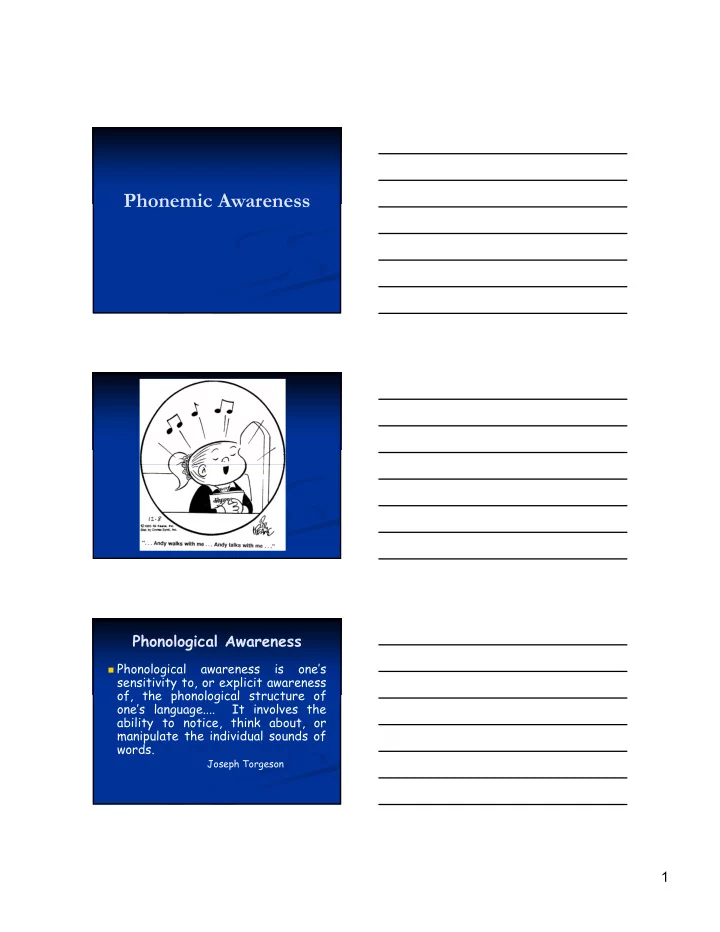

Phonemic Awareness Phonological Awareness Phonological awareness is one’s sensitivity to, or explicit awareness of, the phonological structure of one’s language.... It involves the ability to notice, think about, or manipulate the individual sounds of words. Joseph Torgeson 1
Phonemic Awareness is: 1) the ability to hear and manipulate the sounds in spoken words and the understanding that spoken words and syllables are made up of sequences of speech sounds (Yopp 1992). Phonemic Awareness is: 2) essential to learning to read in an alphabetic writing system, because letters represent sounds or phonemes. Without phonemic awareness, phonics makes little sense. Phonemic Awareness is: 3) fundamental to mapping speech to print. If a child cannot hear that “man” and “moon” begin with the same sound or cannot blend the sounds /rrrruuuunnnn/ into the word “run”, he or she may have great difficulty connecting sounds with their written symbols or blending sounds to make a word. 2
Phonemic Awareness is: 4) essential to learning to read in an alphabetic writing system. Phonemic Awareness is: 5) a strong predictor of children who experience early reading success. Early Identification and Intervention is Critical For 90 to 95% of poor readers prevention and early intervention programs that combine instruction in phoneme awareness, phonics, fluency development and reading comprehension strategies, provided by well trained teachers can increase reading skills to average reading levels. 3
HOWEVER, when intervention is delayed until nine years of age, approximately 75% will continue to have difficulties learning to read throughout high school. Foorman, Shaywitz, Torgesen, Vellutino “The best predictor of reading difficulty in kindergarten or first grade is the inability to segment words and syllables into constituent sound units (phonemic awareness)” Lyon 1995 Phonological awareness can be trained and such training makes a difference in beginning reading and spelling achievement. It is an abstraction—that words are made up of sounds The most impressive gains occurred when children received both phoneme awareness training along with instruction in letter sounds. This is effective with individuals or small groups. 4
What is a phoneme? Phonemes are the smallest units composing spoken language. (National Reading Panel 2000) Sun has three phonemes: s…u…n Critical Phonemic Awareness Skills Sound Isolation: The first sound in sun is /ssss/. Blending: /sss/ - /uuu/ - /nnn/ is sun. Segmenting: The sounds in sun are /sss/ - /uuu/ - /nnn/ Phonological Awareness Development Continuum Word Comparison Rhyming Easy Sentence Segmentation to Syllable Segmentation &Blends more Onset-rime blending & segmentation Blending & Segmenting Individual Phonemes Difficult Phoneme Deletion & Manipulation 5
Phonemic Awareness Benchmarks Phonemic awareness instruction typically spans two years, kindergarten and first grade. Kindergarten Benchmarks Children should demonstrate the following skills by the end of Kindergarten 6
Kindergarten Benchmarks Sound and Word Discrimination 1) Tells whether words or sounds are the same or • different (cat/cat =same; cat/car=different). Identifies which word is different (sun, fun, sun) • Tells the difference between single speech • sounds (which one is different? s, s, k) Rhyming 2) Identifies whether words rhyme • (cat/mat; ring/sing) Produces a word that rhymes with another • (A word that rhymes with rose is nose. Tell me another word that rhymes with rose.) Blending 3) Orally blending syllables (mon-key) or onset-rimes • (m-ilk) into a whole word. Orally blends 2-3 separately spoken phonemes into • one-syllable word (m-e: me; u-p: up; f-u-n: fun) 7
Segmentation 4) Claps or counts the words in a 3-5 word sentence • (Sue can jump far) Clap or count the syllables in 1-, 2-, and 3 syllable words. • Says each syllable in 2- to 3- syllable words • (din-no-saur) Identifies the first sound in a one-syllable word (/m/ in • man) Segments individual sounds in 2- and 3- phoneme, one- • syllable words (run: /r/ /u/ /n/; feet: /f/ /ee/ /t/) 25 first sounds per minute by mid-year 35 sound segments per minute by the end of kindergarten First Grade Benchmarks Sound Isolation 1) Identifies initial sounds in one- syllable words. • Identifies final sounds in one-syllable words. • Identifies medial sounds in one- syllable words. • 8
Sound Blending 2) Blends 3-4 phonemes into a whole word • (/m/ /a/ /n/: man; /s/ /k/ /i/ /p/: skip) Sound segmentation 3) Segments 3- and 4- phoneme, one-syllable words • (m-a-n; s-k-i-p) 35-45 first sounds per minute by mid-year 9
Extensions of Segmenting By the end of 1 st and 2 nd , student should be able to demonstrate the following skills: 1. Substituting “Nap. What word do we get when we change the /n/ to /c/?” (as in rhyming or word family practice) 2. Deleting “Flake. What word do we get when we take away /l/ from flake?” 4. Adding “Mile. What word do we get when we add /s/ to the front of mile?” Phonemic Awareness Program and Materials Should Progress from easier phonemic awareness activities to 1) more difficult (rhyming, sound matching to blending, segmentation, and manipulation) Focus on segmentation or the combination for 2) blending and segmenting. Start with larger linguistic units (words and syllables) 3) and proceed to smaller linguistic units (phonemes) Beginning instruction that focuses on the phonemic 4) level of phonological units with short words (2-3 phonemes: at, mud, run) Phonemic Awareness Program and Materials Should Focus first on initial (sat) then final (sat), and lastly the medial 5) sound (sat). Introduce continuous sound (m, r, s) before stop sound (t, b, 6) k) as stop sounds are more difficult to elongate and isolate. Add letter-sound correspondence instruction to phonological 7) awareness interventions after children demonstrate early phonemic awareness. Provide brief instructional sessions. Significant gains in 8) phonemic awareness are often made in 15-20 minutes of daily instruction and practice over a period of 9-12 weeks. (Smith, Simmons, and Kame’enul, 1998) 10
11
Recommend
More recommend